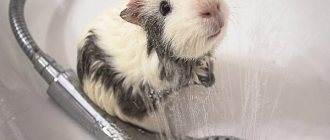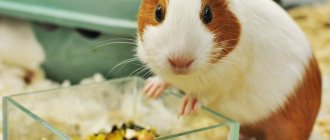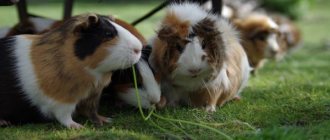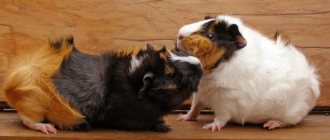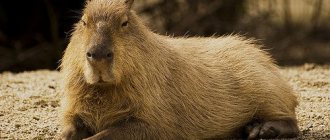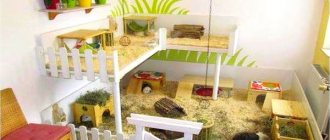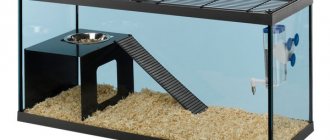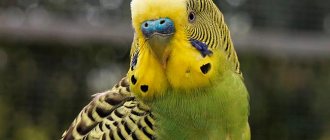- home
- Guinea pig
- Choosing and purchasing a guinea pig
02/14/2019 Guinea pigs are funny and friendly animals. They are popular as pets. Before purchasing, it is useful to study the pros and cons of this animal, find out how to check its health, and also have an idea of where and for what amount to buy it.
Where is the best place to buy
There are three options for purchasing a pet:
- in a pet store;
- from breeders;
- through the Internet.
Purchasing in stores is simple and convenient: together with your pet, you immediately purchase a cage, bowl, water bowl and other accessories. Disadvantages include the inability to verify the health of the pet. The pedigree also remains unknown, making it impossible to find out whether the animal had cases of hereditary diseases in its family. Once in the store, you should pay attention to the conditions in which the animals are kept - whether their bedding is clean, what the smell is, etc.
Breeders' prices are higher than in pet stores, but the animal is accompanied by the necessary health and vaccination certificates, pedigree details, and medical history of relatives. It is possible to choose a guinea pig from several individuals of different colors. In addition, the breeder will share useful information regarding the care and feeding of the pet. You should not trust the seller in absentia. Before contacting him, it is useful to read reviews from former customers.
The most budget-friendly option is to find an advertisement on the Internet about free distribution of guinea pigs. The reason for such generosity is the need to give away cubs, the inability to care for a pet, or an unexpected allergy. In this case, all the risks remain the same as when purchasing from a pet store.
Features of feeding
It is known that guinea pigs are domesticated rodents that feed on dry grass. The basis of their diet is hay. In addition, animals eat grain feed:
- oats;
- corn;
- barley;
- wheat;
- sunflower seeds.
Read more about “How and what to feed your guinea pig.”
It is beneficial for animals to eat vegetables and fruits, as well as fresh herbs. These are valuable sources of vitamins and microelements. In winter, rodents are given grass pellets or grain sprouts. The diet must include branches of fruit trees.
Guinea pigs should not be offered food of animal origin, as well as potatoes, red beets, and citrus fruits. Confectionery and bakery products are strictly prohibited.
Pros and cons of guinea pigs
The advantages of pigs include:
- friendly character;
- unpretentiousness in content;
- strong immunity.
A guinea pig is better suited for a child than a rabbit or hamster. Rabbits are less suited to living in an apartment. They require a lot of space. And hamsters are smaller than pigs, and therefore more fragile. Young children do not yet accurately coordinate their movements and poorly calculate the force with which they pick up pets.
Cons of guinea pigs:
- Noise: Pigs make a variety of sounds, from squeaks to purrs. Sometimes they do this at night.
- Allergies: In some cases, the owner or members of his family develop an allergy to the pet's fur.
- Need for communication. Animals need to be given at least half an hour a day: talk to them, play with them, let them run around.
Animals often sharpen their teeth on the bars of the cage, creating a loud grinding sound. To prevent this, buy mineral stones or wooden toys for your pet to grind down his teeth.
Breed selection
To get a guinea pig, you need to decide for what purpose you are purchasing it. Depending on this decision, the breed is chosen. There are three varieties:
- shorthair;
- long-haired;
- naked.
Short-haired pigs are easy to keep and are relatively cheap. The long-haired breed will take the most time to care for. The fur will have to be combed daily and constantly monitored for cleanliness. But this variety is best suited for participation in exhibitions and competitions. It is better to buy a show pet from professional breeders, because the purebred of the animal is important for winning.
Hairless varieties are represented mainly by the Skinny and Baldwin breeds. They require maintaining a stable warm temperature in the room. Due to the lack of fur, the likelihood of contracting a cold or pneumonia increases.
Cubs of different breeds are similar to each other. Distinctive features appear at a late age, after the juvenile moult, which occurs at 5 months of life.
Conditions of detention
The main maintenance requirement is a fairly spacious cage. For a comfortable stay for one pet, the dimensions of the cage must be at least 40 cm X 100 cm. It is imperative to have a tray with sides, the height of which is approximately 10–15 cm. After all, pigs love to scurry around and burrow into the bedding, so sawdust will fly in different directions. You can set up a house for sleeping in a cage, but if the animal has not yet been tamed, this should not be done, as this will contribute to its final feralization. It is best to use a feeder with a flat bottom, and a hinged, nipple-type drinker. The cage should be located in the brightest place in the room, where there are no drafts or direct sunlight.
Although pigs are, by nature, a little nearsighted, the cage should still be in a room with people so that the animal can both see and hear them. But loud noise is harmful to the animal, so when guests come, it is best to move the cage to a quiet room.
The bedding in the cage must be changed as it gets dirty, about once a week. Pigs are fairly clean animals; their fur is practically odorless. Therefore, there is no need to bathe her. If there is a need for this, it is necessary to use special zoo shampoos for this purpose. The length of the coat in some breeds can reach 25 cm, so it needs to be constantly looked after and brushed frequently. For daily procedures, you need to purchase a special brush.
Animals' claws grow very quickly; they need to be trimmed periodically with special nail clippers. At the same time, you need to pick up your pet very carefully, supporting it under the tummy, and trim the nails carefully, without touching living tissue.
Who is better - a boy or a girl
Character practically does not depend on gender. This parameter depends on the taste of the owner. It's better to get a couple of animals at once. Pigs are social animals; in nature they live in packs. Owners who do not plan to breed purchase a same-sex pair. Different sexes are also allowed, but in this case you will have to take care of sterilization, otherwise the female will often become pregnant.
Determining the sex of an animal on your own is difficult, especially if the individual is young. The genitals are shaped like the letter Y, but males have a slight swelling on top. As they grow older, their testicles stand out noticeably on the sides of the anus. Representatives of both sexes have a pair of nipples on their stomachs.
Age
You should know at what age it is better to buy a guinea pig: 5-10 weeks. Up to three weeks of age, the cubs feed on their mother's milk. It makes up the bulk of their diet and strengthens the immune system. The older an individual is, the longer it takes to adapt to a new home.
It is possible to determine the exact age of the animal only before it reaches one year of age. During this period, the animal continuously grows and gains weight. The body length at 5 weeks is about 19 cm. The average length of an adult is 25–30 cm, weight is 1 kg. In addition, the teeth of young animals are white and even (in the absence of dental problems). After reaching 1 year, the appearance of the animal practically does not change. All you have to do is take the seller’s word for it or find out the age from the veterinarian.
If you want to have a female guinea pig, you should be especially careful. Animals reach sexual maturity by two months, and cases of acquiring pregnant females are not uncommon.
Useful tips
- when planning to purchase a pet, be sure to take into account the additional costs of food, bedding and visits to the veterinarian;
- a cage in advance (for a pair of animals, the cage area is at least 1 sq. m), a drinking bowl, a bowl (separate for each individual), bedding and food;
- the cage must be equipped with shelters - fleece capes, houses, cardboard tunnels, as well as plugs with 2 open ends, providing ventilation in case of heat;
- be especially careful when buying a female pet, since puberty in guinea pigs ends at 2 months of age, and there are often cases of selling already pregnant individuals;
- When taking an animal from a shelter, find out the reason for its stay there to determine whether it has any diseases.
Health status
Before purchasing, pay special attention to the appearance of the pet in order to exclude diseases. Signs of a healthy animal:
- A strong torso without signs of emaciation or obesity;
- no unpleasant odor;
- even, deep breathing;
- clean and thick hair (bare areas of skin behind the ears are allowed);
- body temperature 39-39.5 degrees;
- smooth skin without redness, scratch marks or wounds;
- nostrils and eyes are clean, there is no discharge;
- the fur around the anus is not stained with feces. This will mean that the pet has diarrhea caused by poor nutrition or an infectious disease.
It is worth getting a guinea pig if it shows activity and curiosity. Sometimes animals become lethargic during the daytime. It is worth re-observing the animal after a few hours. Constant lethargy, heavy breathing and dirty fur indicate the pet’s poor condition.
The presence of parasites such as fleas or lice eaters is unpleasant, but is not considered a serious illness. They are quickly removed using special means. However, this suggests that the pets were kept in unsuitable conditions.
How much money do you need to start a business?
When you don’t have your own plot of land, you need to rent it. For a livestock of 50 pigs, 20 acres of land is enough, which will cost 30 thousand rubles. per month. Then the main expenses will follow:
- Construction of a pen - 300 thousand rubles;
- Equipment and communications - 400 thousand rubles;
- Purchase of 50 piglets - 600,000 rubles;
- Feed grain and additives - 10,000 rubles. per month;
- Unforeseen expenses - 60 thousand rubles.
If the business is not family-owned, then hiring workers (4-6 people) will cost up to 120 thousand rubles. If marketing firms are involved in selling products, it will cost about 25 thousand rubles. per month. You may need your own website for promotion and advertising, so a computer and website creation will cost up to 30 thousand rubles.
In general, to start a pig farm of 50 heads you will need 1.58 million rubles, and monthly expenses will be 250 thousand rubles (utilities, taxes, insurance, additional expenses, etc.).
Cost of guinea pigs
The cost of animals varies, depending on the breed, from 1000 rubles to 5000 or more. Price formation is influenced by:
- breed;
- pedigree;
- color;
- character;
- age;
- region.
The most expensive ones will be exhibition animals. Not only does the animal cost a lot of money, but further maintenance and care will cost a considerable amount.
Breeding individuals, as a rule, have a good pedigree, which is why their price tag is also higher than the standard. They are purchased for breeding for profit.
If you buy an animal for home keeping, you should get an ordinary mongrel pig. As a pet, they are no worse than purebred individuals.
